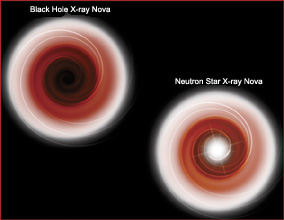Black Hole Son
Most people don't realize how many cool missions NASA has underway, or are yet to be launched. The most well recognized are the Mars Rovers and they have provided some amazing science. NASA also has their Discovery Program, meant to explore the sun, planets, asteroids, and comets of our solar system. One of the probes, Genesis, which collected solar particles from the Sun, crashed in the Utah desert when a component was installed upside down (the perfect example of Murphy's Law!). Other notable instruments are the Hubble Telescope, The Chandra Observatory, SOHO, Spitzer Space Telescope, and the planned James Webb Telescope.
In November of 2004, NASA launched the Swift Observatory whose express purpose is to study Gamma Ray Bursts' (GRB). Gamma ray's are the most energetic form of the electromagnetic spectrum (> 1 million eV). They are produced by nuclear transitions, which leads us to the different types.
Gamma ray bursts are classisfied by their duration. Long bursts last more than two seconds and are thought to occur through stellar explosions in distant galaxies. Shorter bursts, less than two seconds and often times only milliseconds, were thought to be caused by merger's between a black hole and a neutron star, or perhaps a collision between two neutron stars. Enter Swift.
Swift has three main instruments that are able to quickly lock onto gamma ray bursts to identify their source. The Burst Alert Telescope detects initial sources of energy and determines the stellar coordinates. An X-ray telescope then scans the appropriate region of space for the afterglow and provides spectral analysis. Lastly, the Ultraviolet/Optical Telescope can provide follow-up images and analysis. Where does all of this lead us?
On May 9th, Swift detected a short burst, lasting only 50 milliseconds. This means that astronomers have detected, for the first time, the formation (or birth) of a black hole. There is still speculation as to what caused the burst; again, black hole/black hole merger, neutron star/neutron star collision, or neutron star/black hole merger. More data will hopefully illuminate the question marks. The energy source itself is located approximately 2.7 billion light years away and is full of old stars, which supports the hypothesis involving neutron stars and black holes.
Further observations are going to be done with the Hubble Telescope and the Keck Telescopes, located in Hawaii. All in all, an exiciting time to be an astronomer.

Illustration: CXC/M.Weiss







No comments:
Post a Comment